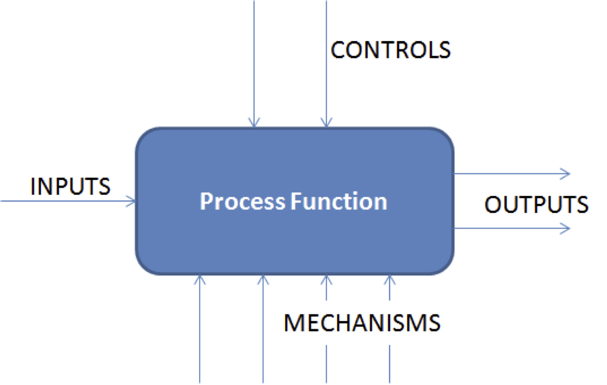
Question: How do you partner with the IT/development resources for your capture platform during the process of designing or optimizing forms?
JOHN KNOTTS, @johnrknotts
So, this is a tactical solution to a strategic problem in the organization. Let me share my ideas on a way to truly understand all your document processes—not just the one that deals with designing documents.
I'm going to introduce something a bit foreign to many but very valuable for this type of effort—it's called IDEF0 Process Modeling. IDEF stands for Integrated Definition and "0" is the level of the process model. IDEF modeling is similar to other forms of process mapping but with some significant differences when it comes to decomposition of the model and the not-so-sequential flow of the model.
The way that IDEF0 can really help end-to-end document management is with the Controls and Mechanisms parts of the map. Controls are things like doctrine, regulations, laws, policies, standards, guidelines, etc. that control the way the process function is performed. Mechanisms include software, systems, facilities, equipment and tools, personnel resources, etc. that "feed" the function. Using this modeling technique for your entire document management domain—taking the process one major function at a time—can provide you a really strong integrated picture that will help with dealing with IT.

This is a difficult problem for many organizations and has profound consequences for the efficiency and effectiveness of operations. It’s not uncommon, for example, to find organizations where 60% to 80% of their inbound forms were originated in house yet lack the forms optimization elements (such as barcodes) that would reduce the time and effort needed to process them. And when you look at the typical organization’s forms capabilities, it’s not surprising.
The way that IDEF0 can really help end-to-end document management is with the Controls and Mechanisms parts of the map. Controls are things like doctrine, regulations, laws, policies, standards, guidelines, etc. that control the way the process function is performed. Mechanisms include software, systems, facilities, equipment and tools, personnel resources, etc. that "feed" the function. Using this modeling technique for your entire document management domain—taking the process one major function at a time—can provide you a really strong integrated picture that will help with dealing with IT.

JOE SHEPLEY, @joeshepley
This is a difficult problem for many organizations and has profound consequences for the efficiency and effectiveness of operations. It’s not uncommon, for example, to find organizations where 60% to 80% of their inbound forms were originated in house yet lack the forms optimization elements (such as barcodes) that would reduce the time and effort needed to process them. And when you look at the typical organization’s forms capabilities, it’s not surprising.
In general, departments all across the organization own their own forms, with little to no central oversight. Few firms have a single (or even rationalized) technology platform for creating, publishing and delivering forms, so all these decentralized forms from across the enterprise traverse their life cycle on siloed systems, often run by different IT groups.
What’s needed to correct this is an enterprise forms group that is responsible for ensuring a rational, coordinated and effective approach to forms. Typically, they develop a strategic vision for forms that articulates the goals of the program, e.g., paper reduction, increased customer self-service, automated back office processing, born digital capabilities, etc., and then work with forms owners across the enterprise to inventory forms, rationalize them (i.e., reduce duplication), optimize them (e.g., add barcodes, standardize structure, etc.) and find the right mix of technology to establish a manageable, effective and affordable platform to create, publish and deliver them.
John Knotts is a results-oriented business professional working out of the San Antonio, TX area. He leads strategic transformations and has extensive experience in strategy, change, process, communication and many other areas.
Joe Shepley brings more than 12 years of operational and technology experience to his consulting engagements at Doculabs. He also currently serves as the conference chair for the DOCUMENT Strategy Forum.
Joe Shepley brings more than 12 years of operational and technology experience to his consulting engagements at Doculabs. He also currently serves as the conference chair for the DOCUMENT Strategy Forum.
Remember to check back every Monday and Wednesday, as we feature a new answer to your questions each week. This is a special Q&A in partnership with the DOCUMENT Strategy Forum. For more information on how to build the document strategy or on attending the DOCUMENT Strategy Forum, visit www.documentstrategyforum.com.




















